The Research on the Construction and the Photocatalytic Performance of BiOI/NH2-MIL-125(Ti) Composite
Abstract
:1. Introduction
2. Results
2.1. Characterization
2.1.1. Photocatalyst XRD Patterns
2.1.2. XPS Analysis of the Photocatalysts
2.1.3. Photocatalyst Morphologies
2.1.4. Surface Area and Pore Volume Characterization
2.1.5. UV–Visible Absorption Spectra and Band Gap
2.1.6. Electrochemical Analysis
2.1.7. Analysis of Adsorption Properties
2.1.8. Photocatalytic Performance
2.2. Proposed Mechanism for the BiOI/NH2-MIL-125(Ti) Composite
2.2.1. Active Species Trapping Experiments
2.2.2. Proposed Mechanism for the BiOI/NH2-MIL-125(Ti) Composite
3. Materials and Methods
3.1. Reagents and Apparatus
3.2. Preparation of NH2-MIL-125(Ti)
3.3. Preparation of BiOI/NH2-MIL-125(Ti) (BNMT) Composite
3.4. Photocatalytic Activity Evaluation
3.5. Active Species Capture Experiments
4. Conclusions
Author Contributions
Funding
Institutional Review Board Statement
Informed Consent Statement
Data Availability Statement
Conflicts of Interest
References
- Li, H.; Ai, Z.H.; Zhang, L.Z. Surface structure-dependent photocatalytic O2 activation for pollutant removal with bismuth oxyhalides. Chem. Commun. 2020. [Google Scholar] [CrossRef]
- Taylor, D.; Dalgarno, S.J.; Xu, Z.T.; Vilela, F. Conjugated porous polymers: Incredibly versatile materials with far-reaching applications. Chem. Soc. Rev. 2020, 49, 3981–4042. [Google Scholar] [CrossRef] [PubMed]
- Fang, X.; Kalathil, S.; Reisner, E. Semi-biological approaches to solar-to-chemical conversion. Chem. Soc. Rev. 2020, 49, 4926–4952. [Google Scholar] [CrossRef] [PubMed]
- Janicki, T.; Krupiński, M.; Długoński, J. Degradation and toxicity reduction of the endocrine disruptors nonylphenol, 4-tert-octylphenol and 4-cumylphenol by the non-ligninolytic fungus Umbelopsis isabelline. Bioresour. Technol. 2016, 200, 223–229. [Google Scholar] [CrossRef]
- Lei, Y.Q.; Wang, G.H.; Song, S.Y.; Fan, W.Q.; Pang, M.; Tang, J.K.; Zhang, H.J. Room temperature, template-free synthesis of BiOI hierarchical structures: Visible-light photocatalytic and electrochemical hydrogen storage properties. Dalton Trans. 2010, 39, 3273–3278. [Google Scholar] [CrossRef]
- Martínez-Huitle, C.A.; Ferro, S. Electrochemical oxidation of organic pollutants for the wastewater treatment: Direct and indirect processes. Chem. Soc. Rev. 2006, 35, 1324–1340. [Google Scholar] [CrossRef]
- Abdel-Aty, A.M.; Salama, W.H.; El-Badry, M.O.; Salah, H.A.; Barakat, A.Z.; Fahmy, A.S.; Mohamed, S.A. Purification and characterization of peroxidases from garden cress sprouts and their roles in lignification and removal of phenol and p-chlorophenol. J. Food Biochem. 2020. [Google Scholar] [CrossRef]
- Dong, H.J.; Zhang, X.X.; Li, J.M.; Zhou, P.J.; Yu, S.Y.; Song, N.; Liu, C.B.; Che, G.B.; Liu, C.M. Construction of morphology-controlled nonmetal 2D/3D homojunction towards enhancing photocatalytic activity and mechanism insight. Appl. Catal. B Environ. 2020, 263, 118270. [Google Scholar] [CrossRef]
- Hu, H.Y.; Lin, Y.; Hu, Y.H. Core-shell structured TiO2 as highly efficient visible light photocatalyst for dye degradation. Catal. Today 2020, 341, 90–95. [Google Scholar] [CrossRef]
- Ma, Y.; Xu, Y.G.; Ji, X.Y.; Xie, M.; Jiang, D.; Yan, J.; Song, Z.L.; Xu, H.; Li, H.M. Construction of polythiophene/Bi4O5I2 nanocomposites to promote photocatalytic degradation of bisphenol a. J. Alloys Compd. 2020, 823, 153773. [Google Scholar] [CrossRef]
- Zhu, Y.Y.; Wang, Y.J.; Ling, Q.; Zhu, Y.F. Enhancement of full-spectrum photocatalytic activity over BiPO4/Bi2WO6 composites. Appl. Catal. B Environ. 2017, 200, 222–229. [Google Scholar] [CrossRef] [Green Version]
- Mera, A.C.; Moreno, Y.; Pivan, J.Y.; Peña, O.; Mansilla, H.D. Solvothermal synthesis of BiOI microspheres: Effect of the reaction time on the morphology and photocatalytic activity. J. Photochem. Photobiol. A 2014, 289, 7–13. [Google Scholar] [CrossRef]
- Lan, H.C.; Zhang, G.; Zhang, H.W.; Liu, H.J.; Liu, R.P.; Qu, J.H. Solvothermal synthesis of BiOI flower-like microspheres for efficient photocatalytic degradation of BPA under visible light irradiation. Catal Commun. 2017, 98, 9–12. [Google Scholar] [CrossRef]
- Zhu, L.F.; He, C.; Huang, Y.L.; Chen, Z.H.; Xia, D.H.; Su, M.H.; Xiong, Y.; Li, S.Y.; Shu, D. Enhanced photocatalytic disinfection of E. coli 8099 using Ag/BiOI composite under visible light irradiation. Sep. Purif. Technol. 2012, 91, 59–66. [Google Scholar] [CrossRef]
- Lin, J.N.; Hu, Z.; Li, H.; Qu, J.Q.; Zhang, M.; Liang, W.J.; Hu, S. Ultrathin nanotubes of Bi5O7I with a reduced band gap as a high-performance photocatalyst. Inorg. Chem. 2019, 58, 9833–9843. [Google Scholar] [CrossRef] [PubMed]
- Zhang, Y.H.; Shan, G.Q.; Dong, F.F.; Wang, C.S.; Zhu, L.Y. Glass fiber supported BiOI thinfilm fixed-bed photocatalytic reactor for water decontamination under solar light irradiation. J. Environ. Sci. 2019, 80, 277–286. [Google Scholar] [CrossRef] [PubMed]
- Zhou, P.Y.; Zhang, A.C.; Zhang, D.; Feng, C.X.; Su, S.; Zhang, X.M.; Xiang, J.; Chen, G.Y.; Wang, Y. Efficient removal of Hg0 from simulated flue gas by novel magnetic Ag2WO4/BiOI/CoFe2O4 photocatalysts. Chem. Eng. J. 2019, 373, 780–791. [Google Scholar] [CrossRef]
- Chen, F.; Huang, H.W.; Zhang, Y.H.; Zhang, T.R. Achieving UV and visible-light photocatalytic activity enhancement of AgI/BiOIO3 heterostructure: Decomposition for diverse industrial contaminants and high mineralization ability. Chin. Chem. Lett. 2017, 28, 2244–2250. [Google Scholar] [CrossRef]
- Wang, J.C.; Yao, H.C.; Fan, Z.Y.; Zhang, L.; Wang, J.S.; Zang, S.Q.; Li, Z.J. Indirect Z-scheme BiOI/g-C3N4 photocatalysts with enhanced photoreduction CO2 activity under visible light irradiation. ACS Appl. Mater. Interfaces 2016, 8, 3765–3775. [Google Scholar] [CrossRef]
- Meek, S.T.; Greathouse, J.A.; Allendorf, M.D. Metal-organic frameworks: A rapidly growing class of versatile nanoporous materials. Adv. Mater. 2011, 23, 249–267. [Google Scholar] [CrossRef]
- Horiuchi, Y.; Toyao, T.; Saito, M.; Mochizuki, K.; Iwata, M.; Higashimura, H.; Anpo, M.; Matsuoka, M. Visible-light-promoted photocatalytic hydrogen production by using an amino-functionalized Ti(IV) metal-organic framework. J. Phys. Chem. C 2012, 116, 20848–20853. [Google Scholar] [CrossRef]
- Wang, H.; Yuan, X.Z.; Wu, Y.; Zeng, G.M.; Chen, X.H.; Leng, L.J.; Wu, Z.B.; Jiang, L.B.; Li, H. Facile synthesis of amino-functionalized titanium metal-organic frameworks and their superior visible-light photocatalytic activity for Cr (VI) reduction. J. Hazard. Mater. 2015, 286, 187–194. [Google Scholar] [CrossRef] [PubMed]
- Han, L.; Zhang, X.M.; Wu, D.Y. Construction and characterization of BiOI/NH2-MIL-125 (Ti) heterostructures with excellent visible-light photocatalytic activity. J. Mater. Sci. Mater. Electron. 2019, 30, 3773–3781. [Google Scholar] [CrossRef]
- Dai, G.P.; Yu, J.G.; Liu, G. Synthesis and enhanced visible-light photoelectrocatalytic activity of p-n junction BiOI/TiO2 nanotube arrays. J. Phys. Chem. C 2011, 115, 7339–7346. [Google Scholar] [CrossRef]
- Chen, L.L.; Jiang, D.L.; He, T.; Wu, Z.D.; Chen, M. In-situ ion exchange synthesis of hierarchical AgI/BiOI microsphere photocatalyst with enhanced photocatalytic properties. CrystEngComm 2013, 15, 7556–7563. [Google Scholar] [CrossRef]
- Liu, H.; Zhang, J.; Ao, D. Construction of heterostructured ZnIn2S4@NH2-MIL-125(Ti) nanocomposites for visible-light-driven H2 production. Appl. Catal. B Environ. 2018, 221, 433–442. [Google Scholar] [CrossRef]
- Hu, S.; Liu, M.; Guo, X.W.; Li, K.Y.; Han, Y.T.; Song, C.S.; Zhang, G.L. Effects of monocarboxylic acid additives on synthesizing Metal-Organic Framework NH2-MIL-125 with controllable size and morphology. Cryst. Growth Des. 2017, 17, 6586–6595. [Google Scholar] [CrossRef]
- Hu, S.; Liu, M.; Guo, X.W.; Kuang, Z.C.; Li, K.Y.; Song, C.S.; Zhang, G.L. Effect of titanium ester on synthesizing NH2-MIL-125(Ti): Morphology changes from circular plate to octahedron and rhombic dodecahedron. J. Solid. State Chem. 2018, 262, 237–243. [Google Scholar] [CrossRef]
- Zhu, S.R.; Liu, P.F.; Wu, M.K.; Zhao, W.N.; Li, G.C.; Tao, K.; Yi, F.Y.; Han, L. Enhanced photocatalytic performance of BiOBr/NH2-MIL-125(Ti) composite for dye degradation under visible light. Dalton Trans. 2016, 45, 17521–17529. [Google Scholar] [CrossRef]
- Che, H.N.; Liu, L.H.; Che, G.B.; Dong, H.J.; Liu, C.B.; Li, C.M. Control of energy band, layer structure and vacancy defect of graphitic carbon nitride by intercalated hydrogen bond effect of NO3− toward improving photocatalytic performance. Chem. Eng. J. 2019, 357, 209–219. [Google Scholar] [CrossRef]
- Liu, Y.; Guo, H.G.; Zhang, Y.L.; Tang, W.H.; Cheng, X.; Liu, H.W. Activation of peroxymonosulfate by BiVO4 under visible light for degradation of Rhodamine B. Chem. Phys. Lett. 2016, 653, 101–107. [Google Scholar] [CrossRef]
- Hlophe, P.V.; Mahlalela, L.C.; Dlamini, L.N. A composite of platelet-like orientated BiVO4 fused with MIL-125(Ti): Synthesis and characterization. Sci. Rep. 2019, 9, 10044. [Google Scholar] [CrossRef] [PubMed]
- Zhong, Y.; Liu, Y.; Wu, S.; Zhu, Y.; Chen, H.; Yu, X.; Zhang, Y. Facile fabrication of BiOI/BiOCl immobilized films with improved visible light photocatalytic performance. Front. Chem. 2018, 6, 58. [Google Scholar] [CrossRef] [PubMed] [Green Version]
- Zhang, C.J.; Fei, W.H.; Wang, H.Q.; Li, N.J.; Chen, D.Y.; Xu, Q.F.; Li, H.; He, J.H.; Lu, J.M. p-n Heterojunction of BiOI/ZnO nanorod arrays for piezo-photocatalytic degradation of bisphenol A in water. J. Hazard. Mater. 2020, 399, 123109. [Google Scholar] [CrossRef]
- Qin, H.M.; Wang, K.; Jiang, L.S.; Li, J.; Wu, X.Y.; Zhang, G.K. Ultrasonic-assisted fabrication of a direct Z-scheme BiOI/Bi2O4 heterojunction with superior visible lightresponsive photocatalytic performance. J. Alloys Compd. 2020, 821, 153417. [Google Scholar] [CrossRef]
- Liu, G.H.; Wang, H.Y.; Chen, D.H.; Dai, C.C.; Zhang, Z.H.; Feng, Y.J. Photodegradation performances and transformation mechanism of sulfamethoxazole with CeO2/CN heterojunction as photocatalyst. Sep. Purif. Technol. 2020, 237, 116329. [Google Scholar] [CrossRef]
- Jiang, W.; Li, Z.; Liu, C.B.; Wang, D.D.; Yan, G.S.; Liu, B.; Che, G.B. Enhanced visible-light-induced photocatalytic degradation of tetracycline using BiOI/MIL-125(Ti) composite photocatalyst. J. Alloys Compd. 2021, 854, 157166. [Google Scholar] [CrossRef]
- Xiao, X.; Zhang, W.D. Facile synthesis of nanostructured BiOI microspheres with high visible light-induced photocatalytic activity. J. Mater. Chem. 2010, 20, 5866–5870. [Google Scholar] [CrossRef]

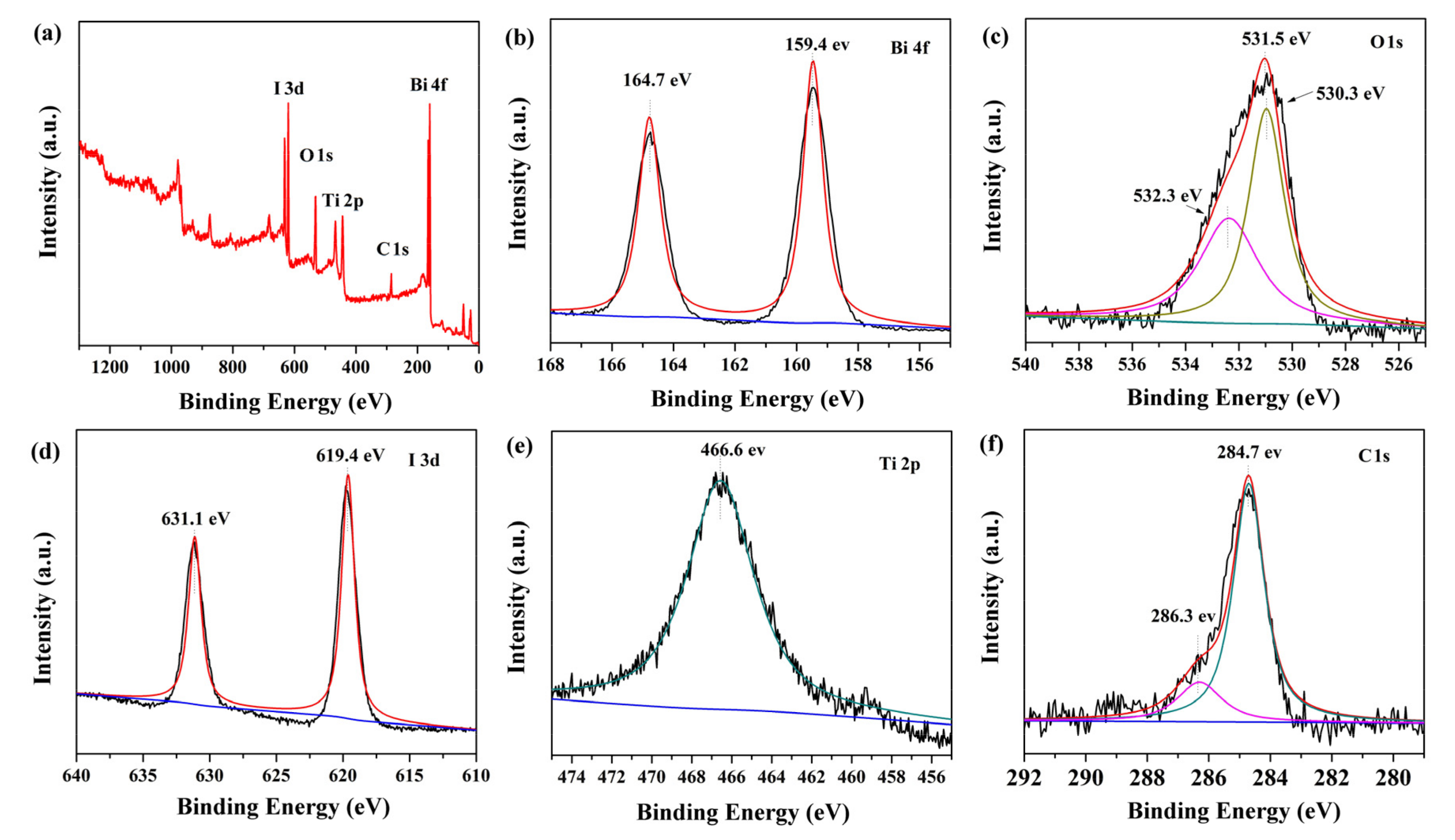
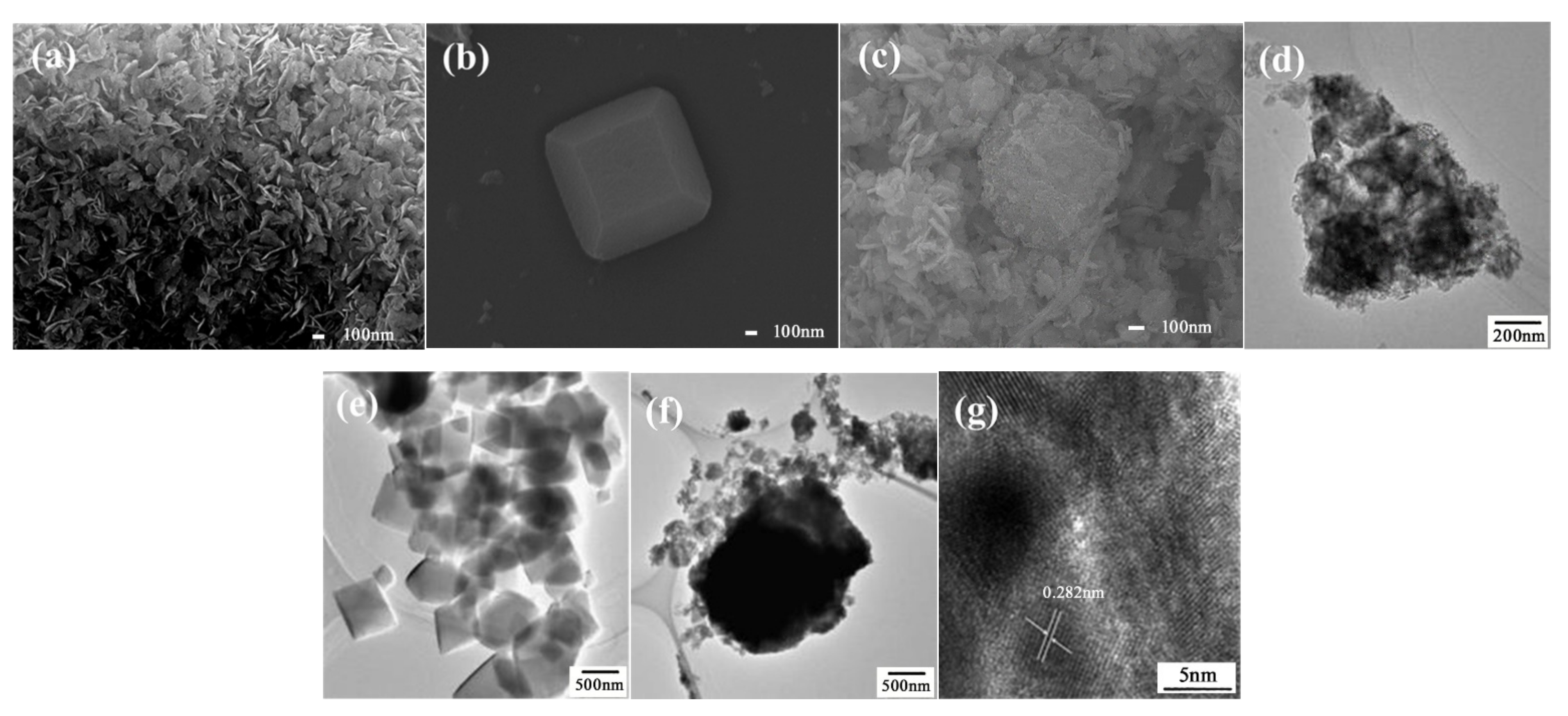

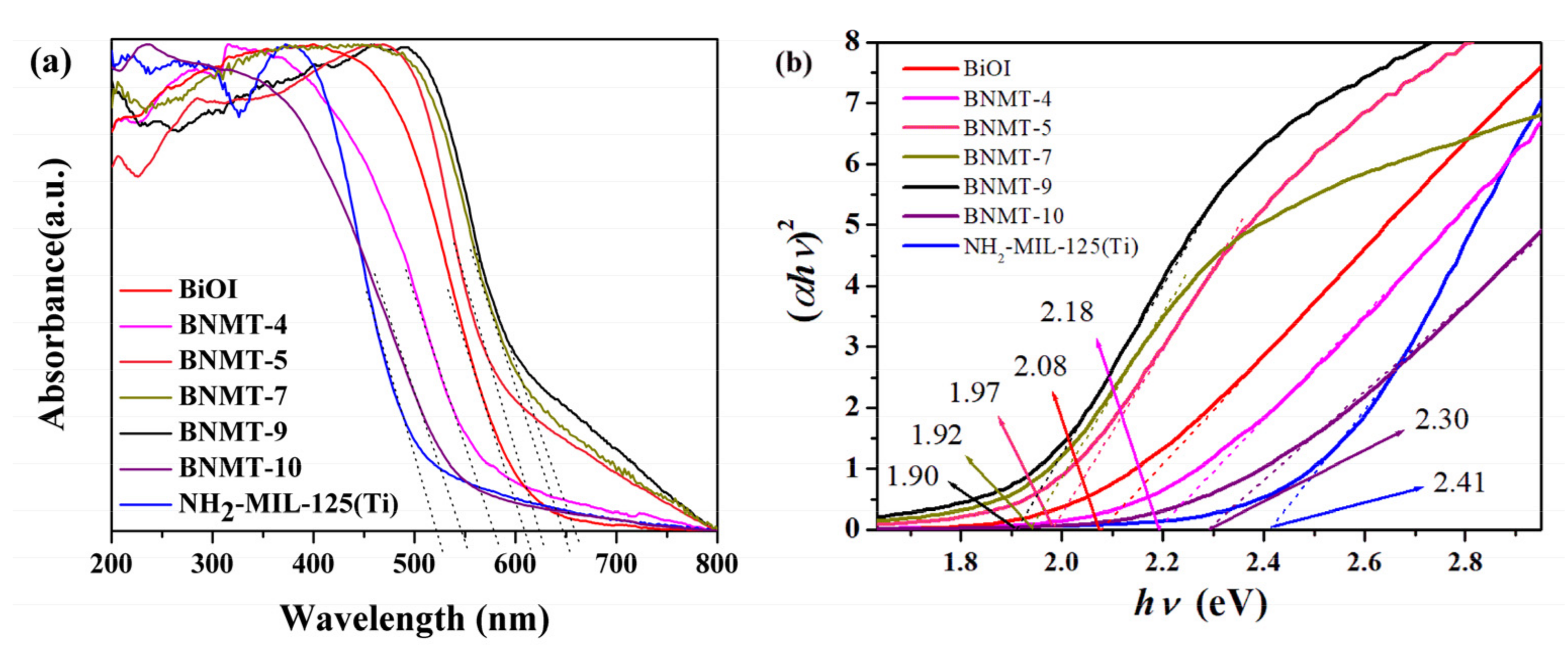



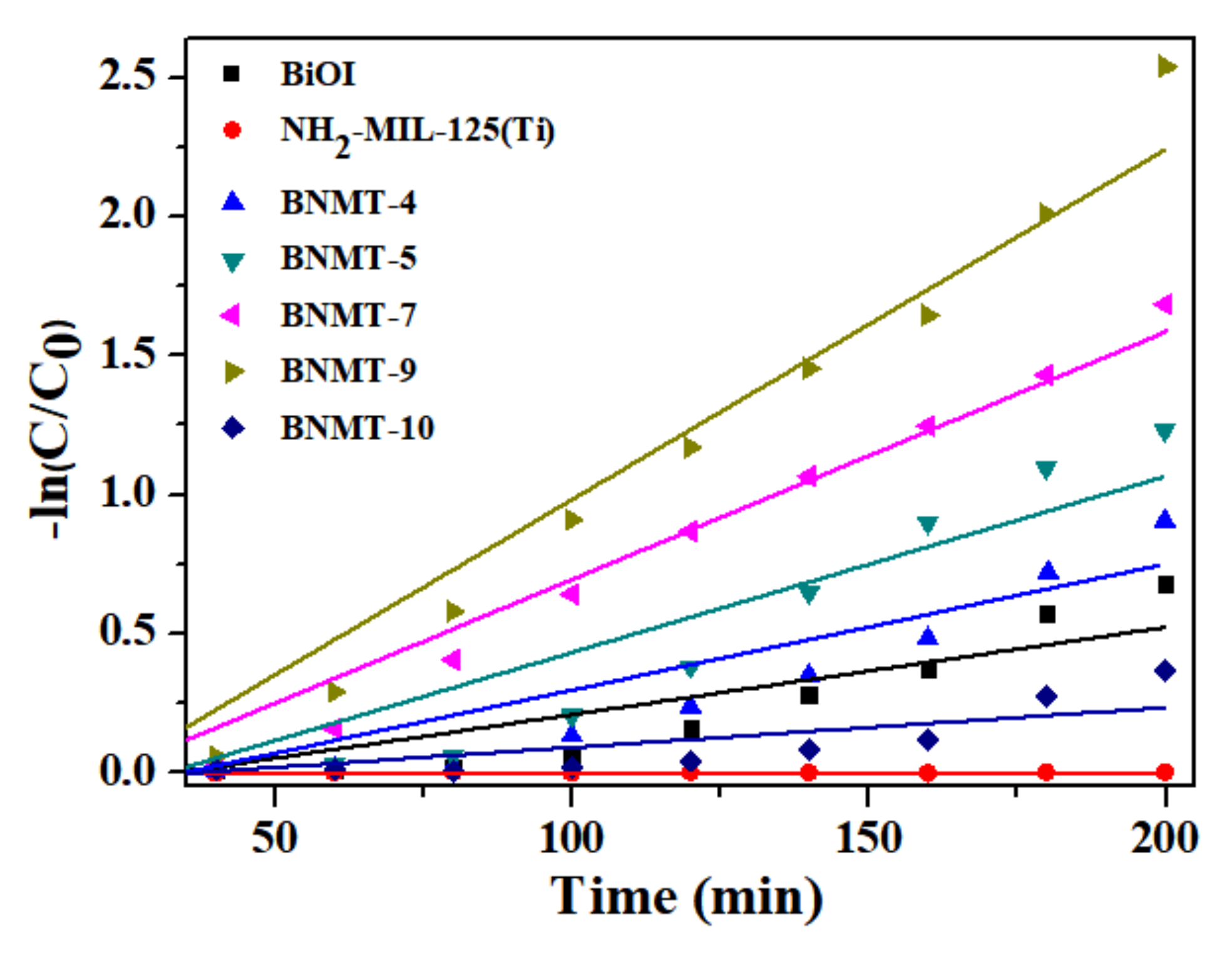
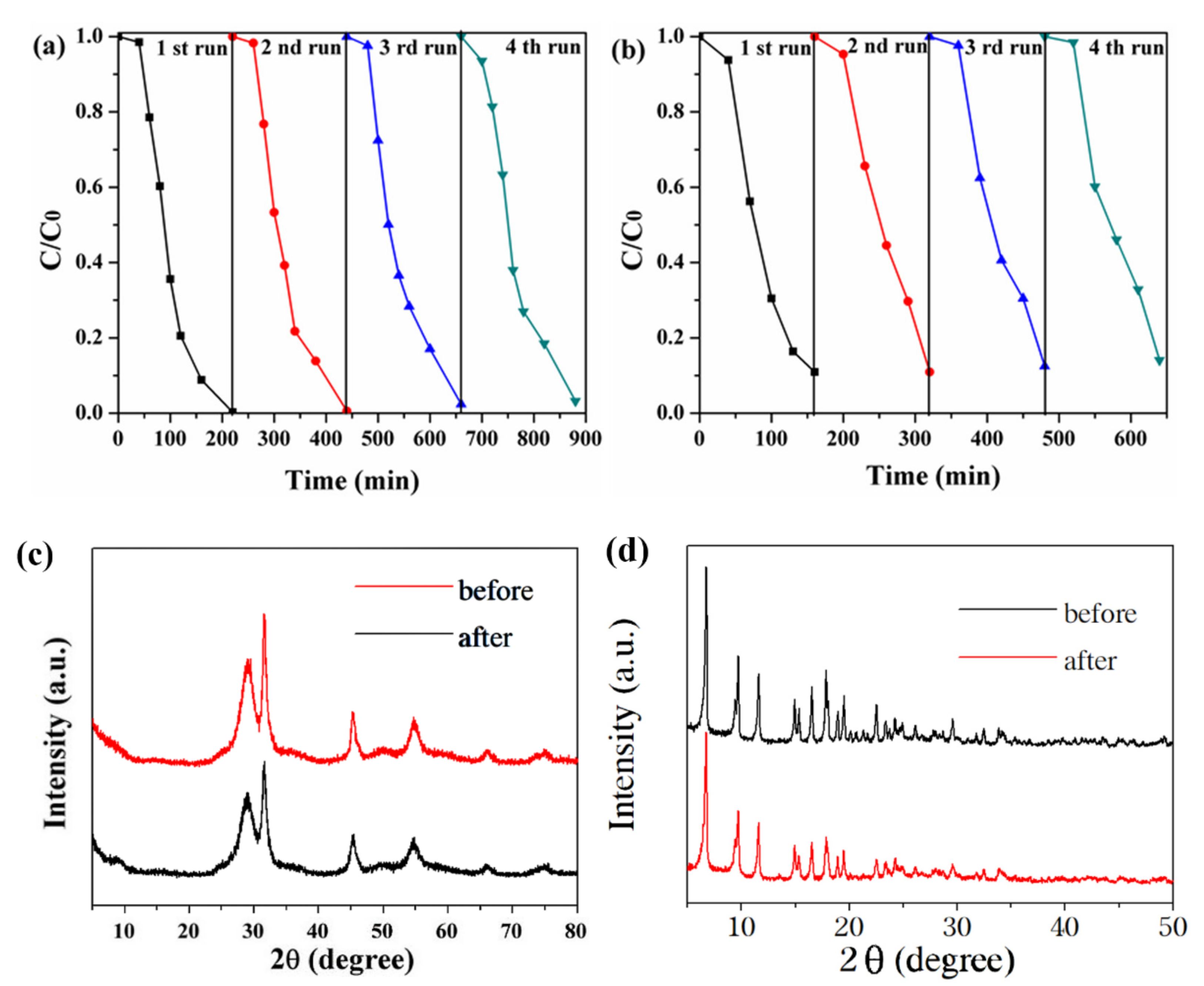
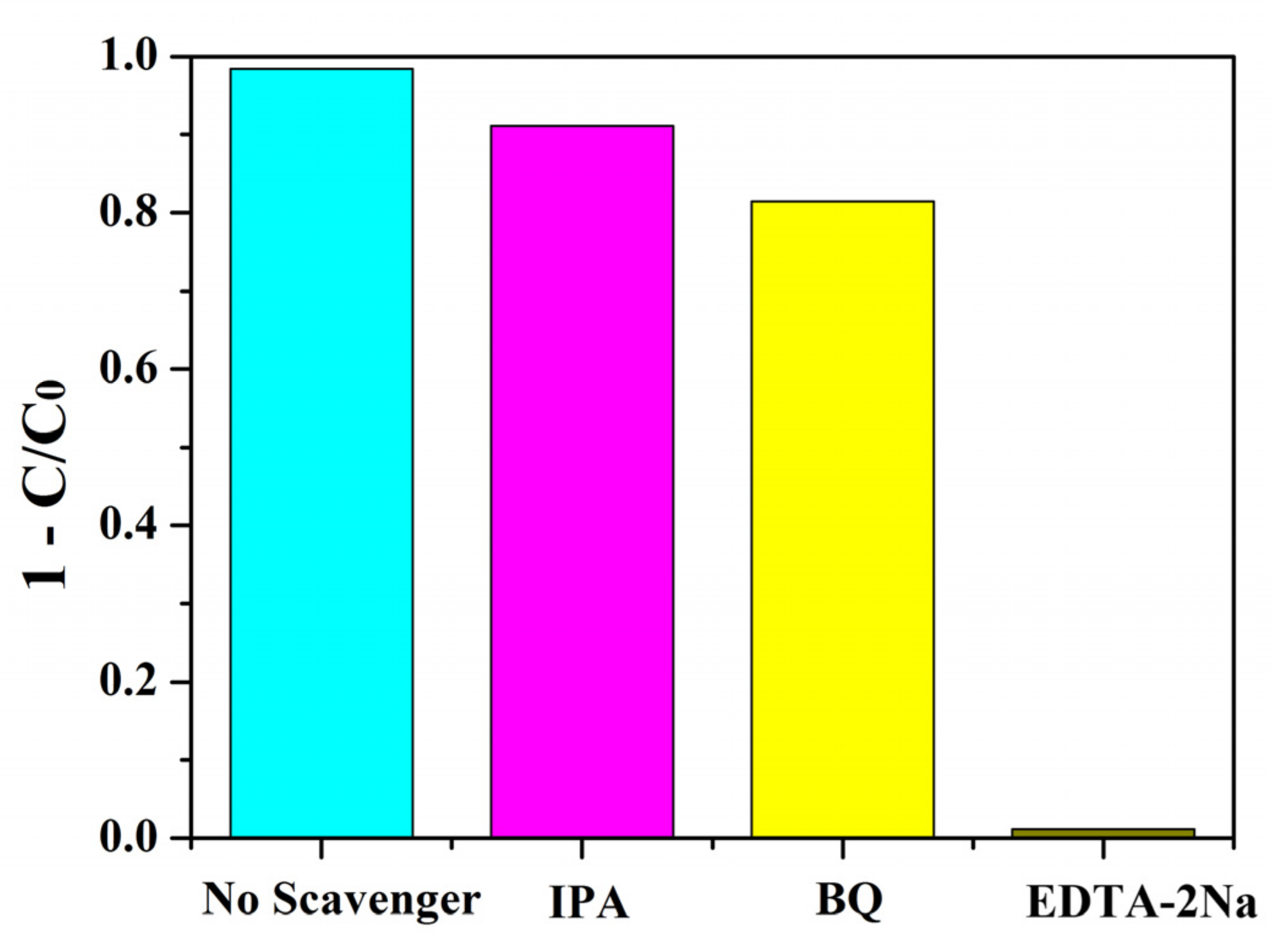
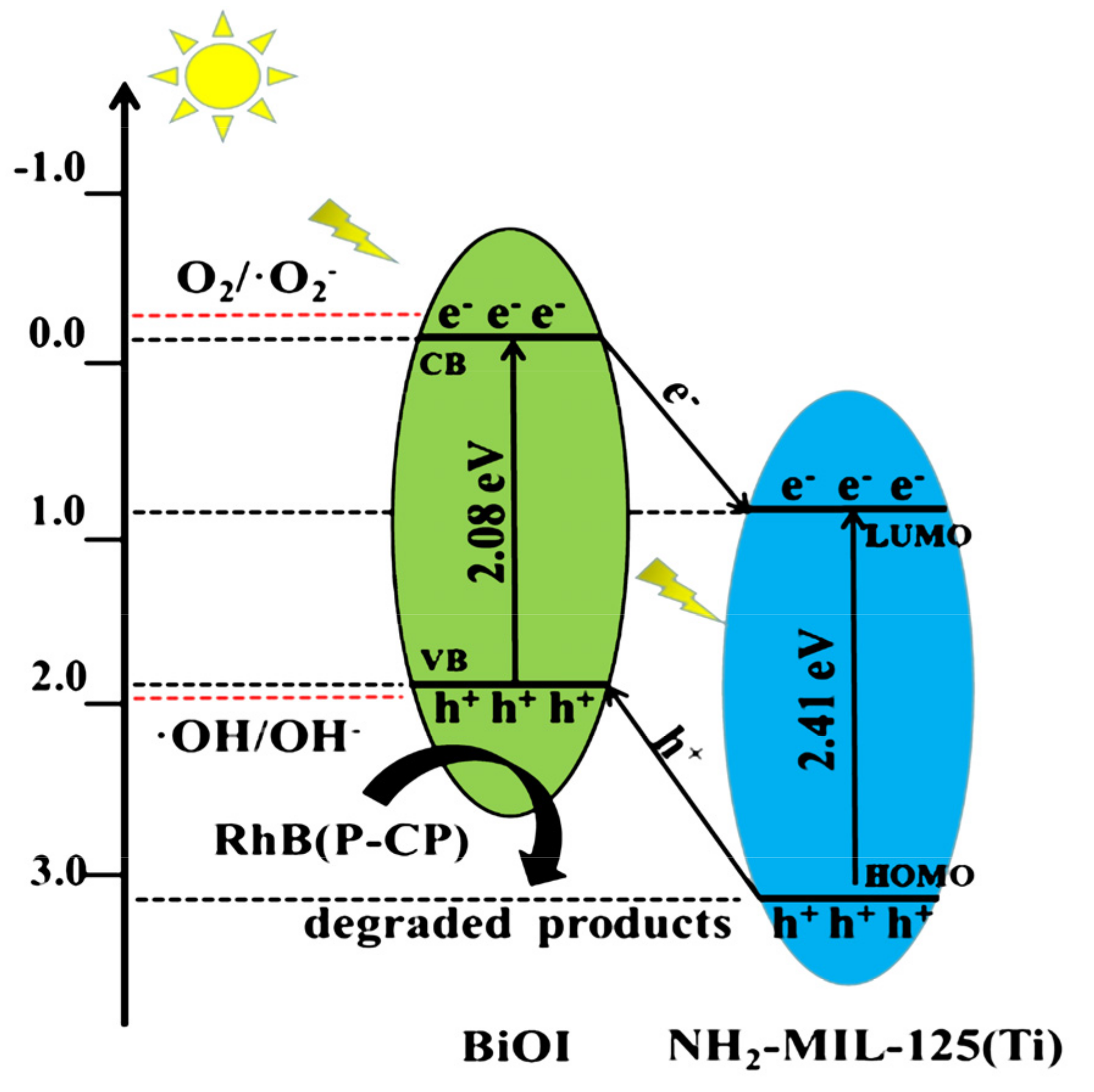
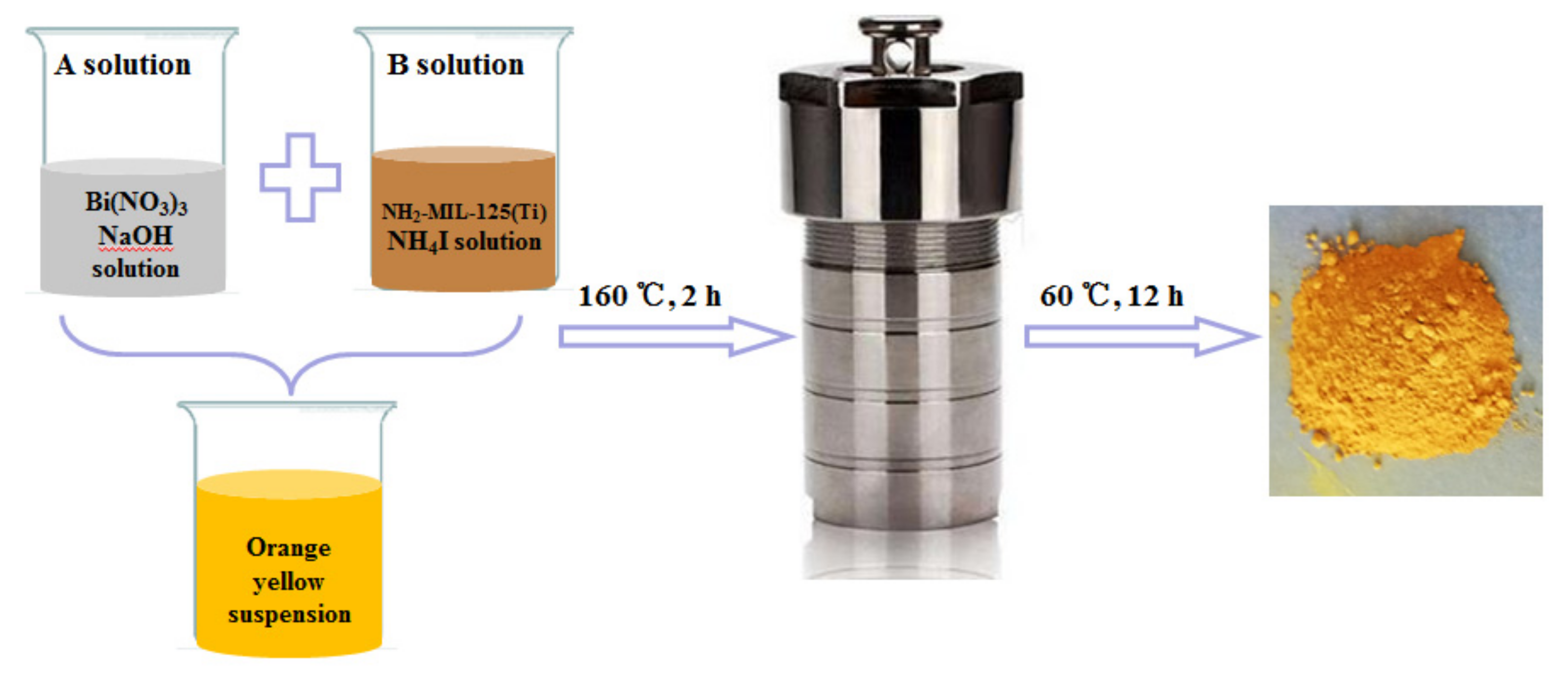
| Sample | SBET (m2/g) | Pore Volume (cm3/g) |
|---|---|---|
| BiOI | 75 | 0.368 |
| BNMT-9 | 12 | 0.468 |
| Sample | Weight Percentage of MOF (wt %) | Quality of MOF (g) |
|---|---|---|
| BNMT-4 | 4 | 0.194 |
| BNMT-5 | 5 | 0.242 |
| BNMT-7 | 7 | 0.339 |
| BNMT-9 | 9 | 0.436 |
| BNMT-10 | 10 | 0.495 |
Publisher’s Note: MDPI stays neutral with regard to jurisdictional claims in published maps and institutional affiliations. |
© 2020 by the authors. Licensee MDPI, Basel, Switzerland. This article is an open access article distributed under the terms and conditions of the Creative Commons Attribution (CC BY) license (http://creativecommons.org/licenses/by/4.0/).
Share and Cite
Du, J.; Zhang, J.; Yang, T.; Liu, R.; Li, Z.; Wang, D.; Zhou, T.; Liu, Y.; Liu, C.; Che, G. The Research on the Construction and the Photocatalytic Performance of BiOI/NH2-MIL-125(Ti) Composite. Catalysts 2021, 11, 24. https://doi.org/10.3390/catal11010024
Du J, Zhang J, Yang T, Liu R, Li Z, Wang D, Zhou T, Liu Y, Liu C, Che G. The Research on the Construction and the Photocatalytic Performance of BiOI/NH2-MIL-125(Ti) Composite. Catalysts. 2021; 11(1):24. https://doi.org/10.3390/catal11010024
Chicago/Turabian StyleDu, Juan, Jiaxin Zhang, Tingyu Yang, Renming Liu, Zhiyi Li, Dandan Wang, Tong Zhou, Yucun Liu, Chunbo Liu, and Guangbo Che. 2021. "The Research on the Construction and the Photocatalytic Performance of BiOI/NH2-MIL-125(Ti) Composite" Catalysts 11, no. 1: 24. https://doi.org/10.3390/catal11010024




